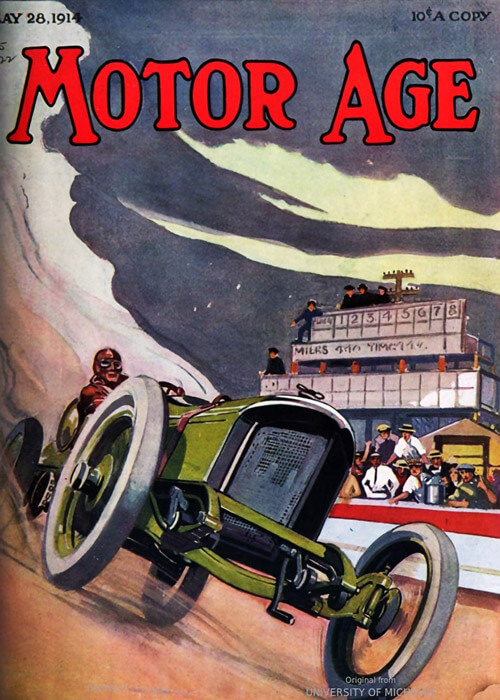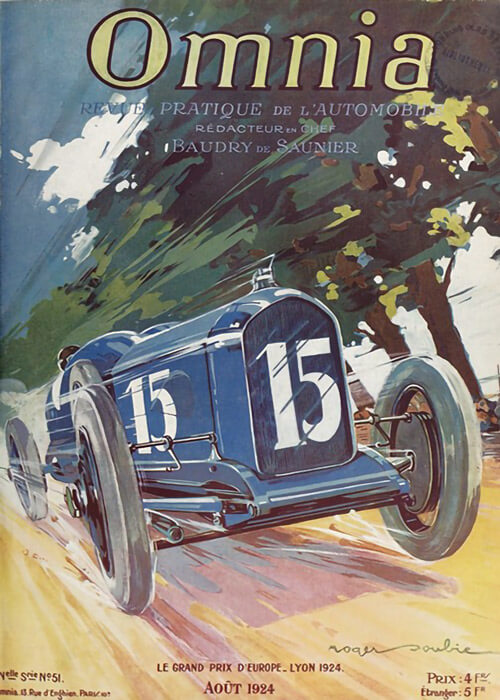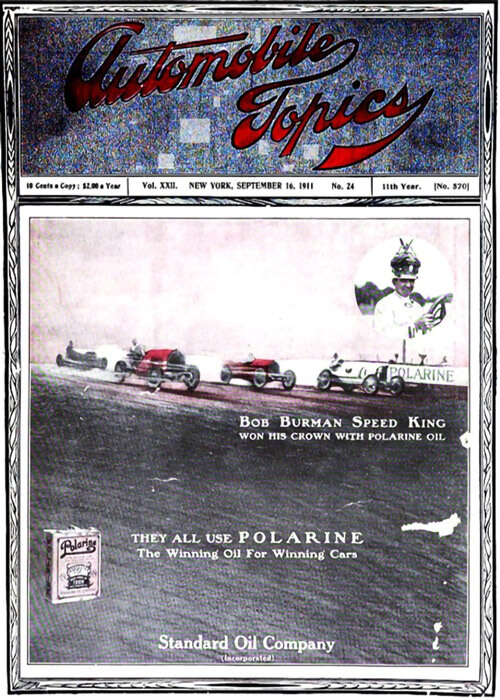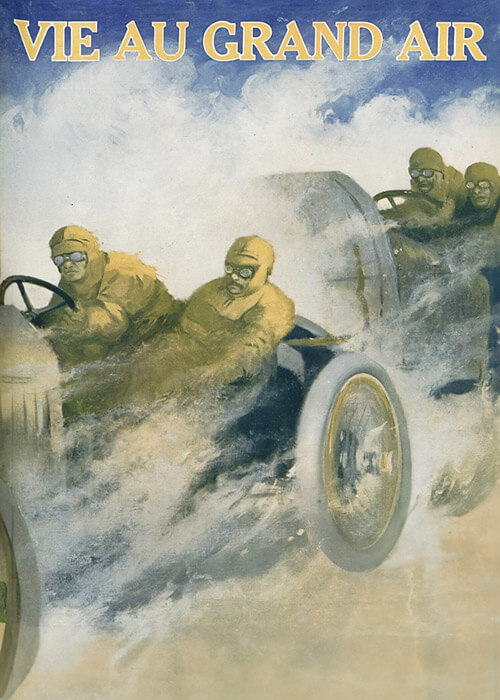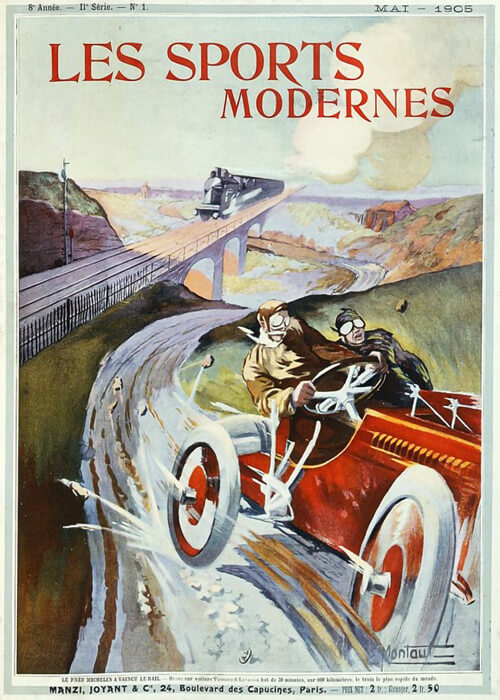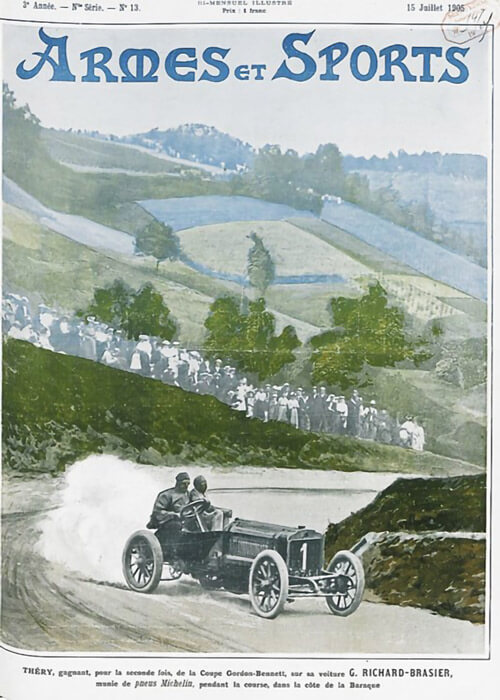This 1903 Paris-Madrid report from La Stampa Sportiva, Italy, also shows warnings and even kind of rejection, when it starts with: „la data del 24 maggio rimarrà scritta a caratteri rossi e doppiamente funesta negli annali dello sport automobilistico.“ Meaning „the date of May 24 will remain written in red letters as a double tragic date in the annals of motor racing.“ Now take that for a start!
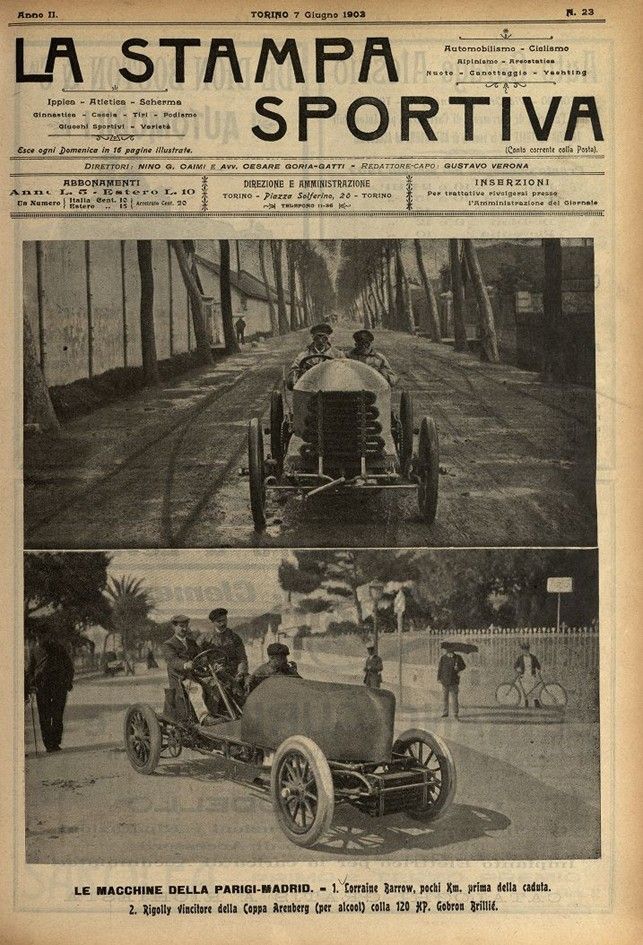
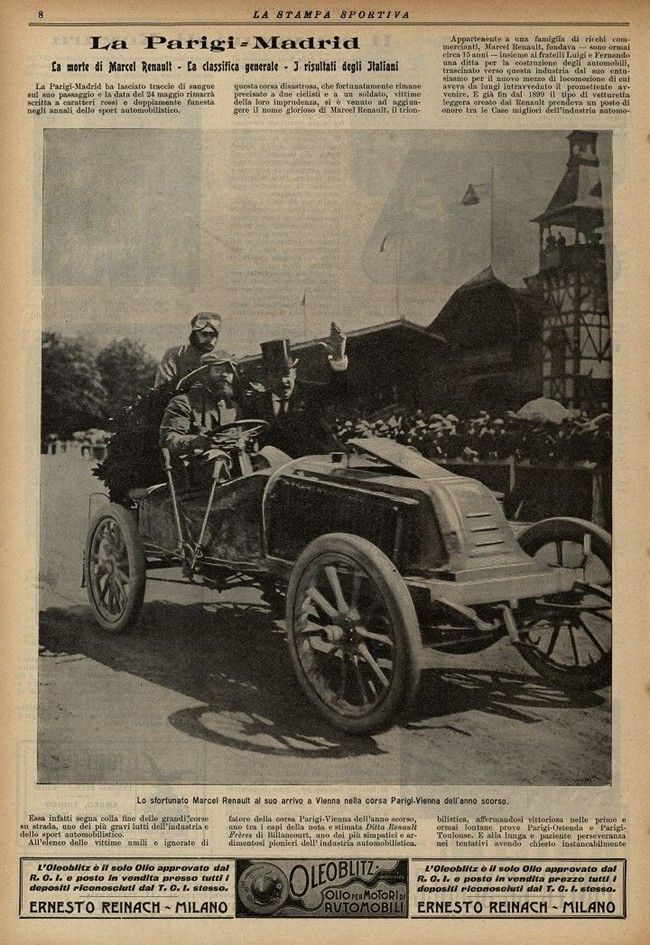
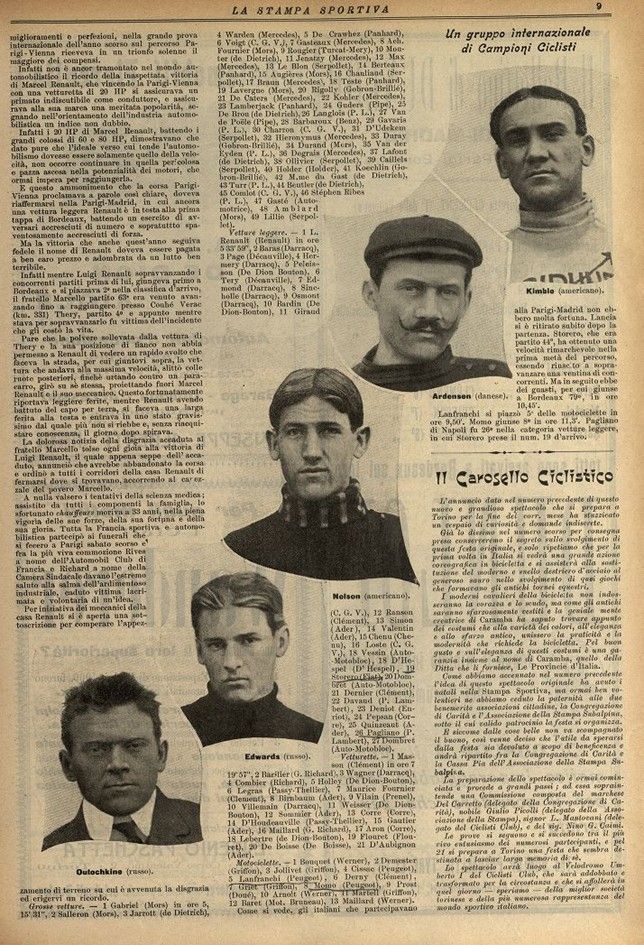
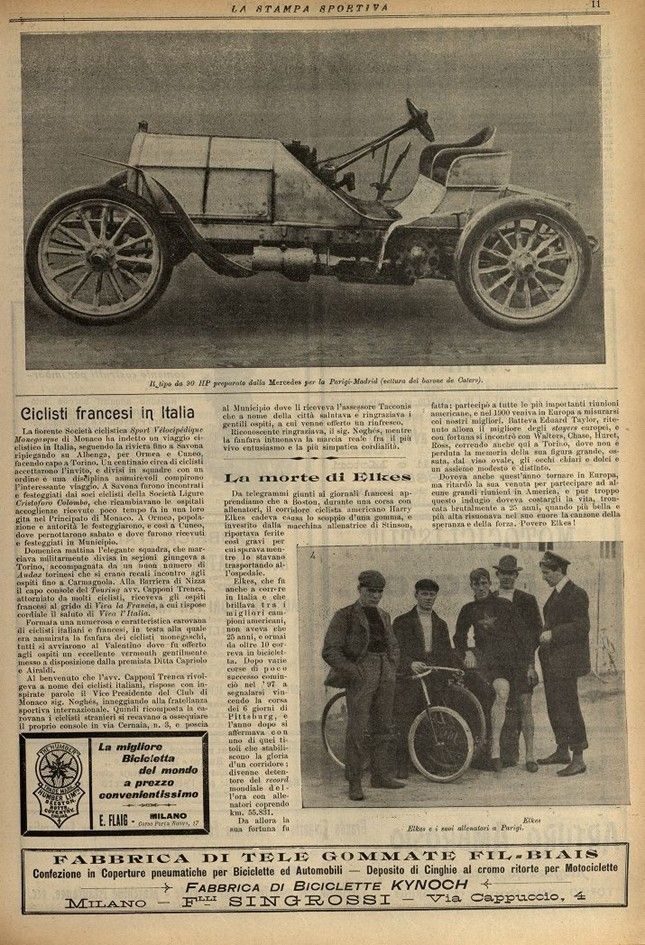
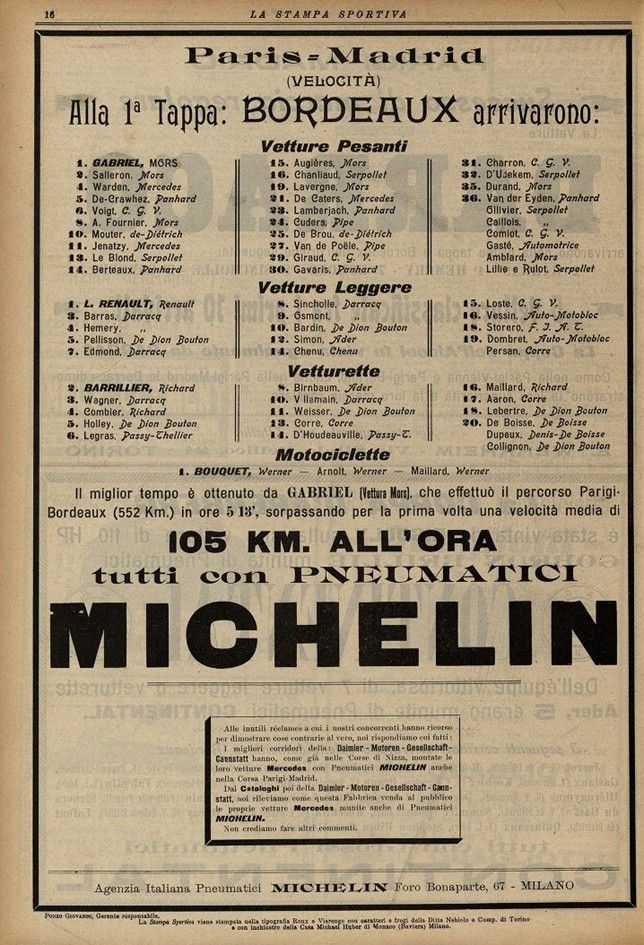
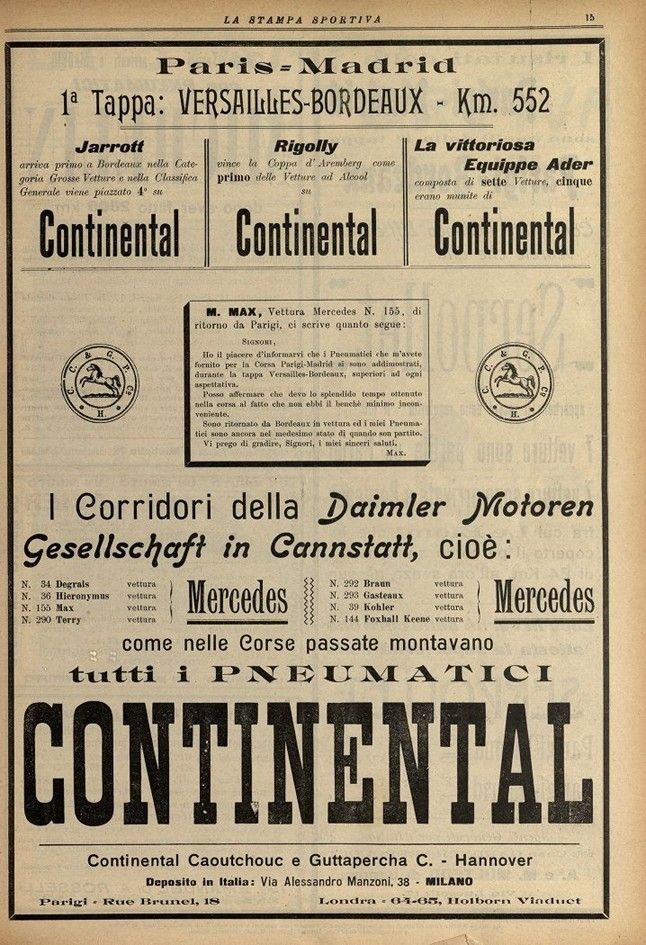
Text and photos with courtesy of Internet Archive archive.org, compiled by motorracingistory.com
LA STAMPA SPORTIVA, Anno II. – Torino – 7 Giugno 1903 – N. 23
La Parigi-Madrid
La morte di Marcel Renault – La classifica generale – 3 risultati degli italiani
La Parigi-Madrid ha lasciato traccio di sangue sul suo passaggio e la data del 24 maggio rimarrà scritta a caratteri rossi e doppiamente funesta negli annali dello sport automobilistico.
Essa, infatti, segna colla line delle grandi corse su strada, uno dei più gravi lutti dell’industria e dello sport automobilistico.
All’elenco delle vittime umili e ignorate di questa corsa disastrosa, che fortunatamente rimane precisato a due ciclisti e a un soldato, vittime della loro imprudenza, si è venuto ad aggiungere il nome glorioso di Marcel Renault, il trionfatore della corsa Parigi-Vienna dell’anno scorso, uno tra i capi della nota e stimata Bitta Renault Frères di Billancourt, uno dei più simpatici e ardimentosi pionieri dell’industria automobilistica.
Appartenente a una famiglia di ricchi commercianti, Marcel Renault, fondava — sono ormai circa 15 anni — insieme ai fratelli Luigi e Fernando una ditta per la costruzione degli automobili, trascinato verso questa industria dal suo entusiasmo per il nuovo mezzo di locomozione di cui aveva da lungi intravveduto il promettente avvenire. E già fin dal 1899 il tipo di vetturetta leggera creato dai Renault prendeva un posto di onore tra le Case migliori dell’industria automobilistica, affermandosi vittoriosa nelle prime e ormai lontane prove Parigi-Ostenda e Parigi-Toulouse. E alla lunga e paziente perseveranza nei tentativi avendo chiesto instancabilmente miglioramenti e perfezioni, nella grande prova internazionale dell’anno scorso sul percorso Parigi-Vienna riceveva in un trionfo solenne il maggiore dei compensi.
Infatti, non è ancor tramontato nel mondo automobilistico il ricordo della inaspettata vittoria di Marcel Renault, che vincendo la Parigi-Vienna con una vetturetta di 20 HP si assicurava un primato indiscutibile come conduttore, e assicurava alla sua marca una meritata popolarità, segnando nell’orientamento dell’industria automobilistica un indice non dubbio.
Infatti, i 20 HP di Marcel Renault, battendo ì grandi colossi di 60 e 80 HP, dimostravano che dato pure che l’ideale verso cui tende l’automobilismo dovesse essere solamente quello della velocità, non occorre continuare in quella pericolosa e pazza ascesa nella potenzialità dei motori, che ormai impera per raggiungerla.
E questo ammonimento che la corsa Parigi-Vienna proclamava a parole così chiare, doveva riaffermarsi nella Parigi-Madrid, in cui ancora una vettura leggera Renault è in testa alla prima tappa di Bordeaux, battendo un esercito di avversari accresciuti di numero e soprattutto spaventosamente accresciuti di forza.
Ma la vittoria che anche quest’anno seguiva fedele il nome di Renault doveva essere pagata a ben caro prezzo e adombrata da un lutto ben terribile.
Infatti, mentre Luigi Renault sopravanzando ì concorrenti partiti prima di lui, giungeva primo a Bordeaux e si piazzava 2° nella classifica d’arrivo, il fratello Marcello partito 63′ era venuto avanzando fino a raggiungere presso Couhé-Vérac (km. 331) Théry, partito 4» e appunto mentre stava per sopravanzarlo fu vittima dell’incidente che gli costò la vita.
Pare che la polvere sollevata dalla vettura ili Théry e la sua posizione di fianco non abbia permesso a Renault di vedere un rapido svolto che faceva la strada, per cui giuntovi sopra, la vettura che andava alla massima velocità, slittò colle ruote posteriori, finché urtando contro un paracarro, girò su sé stessa, proiettando fuori Marcel Renault e il suo meccanico. Questo fortunatamente riportava leggiere ferite, mentre Renault avendo battuto del capo per terra, si faceva una larga ferita alla testa e entrava in uno stato gravissimo dal quale più non si riebbe e, senza riacquistare conoscenza, il giorno dopo spirava.
La dolorosa notizia della disgrazia accaduta al fratello Marcello tolse ogni gioia alla vittoria di Luigi Renault, il quale appena seppe dell’accaduto, annunciò che avrebbe abbandonato la corsa e ordinò a tutti i corridori della casa Renault di fermarsi dove si trovavano, accorrendo al capezzale del povero Marcello.
A nulla valsero i tentativi della scienza medica; assistito da tutti i componenti la famiglia, lo sfortunato chauffeur moriva a 33 anni, nella piena vigoria delle sue forze, della sua fortuna e della sua gloria. Tutta la Francia sportiva e automobilistica partecipò ai funerali che si fecero a Parigi sabato scorso e fra la più viva commozione Rives a nome dell’Automobil Club di Francia e Richard a nonio della Camera Sindacale davano l’estremo saluto alla salma dell’ardimentoso industriale, caduto vittima lacrimata e volontaria di un’idea.
Per iniziativa dei meccanici della casa Renault si è aperta una sottoscrizione per comperare l’appezzamento di terreno su cui è avvenuta la disgrazia ed erigervi un ricordo.
Grosse vetture. — 1 Gabriel (Mors) in ore 5, 15′ 31″, 2 Salleron (Mors), 3 Jarrott (de Dietrich), 4 Warden (Mercedes), 5 De Crawliez (Panhard), 6 Voigt (C. G. V.), 7 Gasteaux (Mercedes), 8 Ach. Fournier (Mors), 9 Rougier (Turcat-Mery), 10 Monter (de Dietrich), 11 Jenatzy (Mercedes), 12 Max (Mercedes), 13 Le Blon (Serpollet), 14 Berteaux (Panhard), 15 Augières (Mors), 16 Chanliaud (Serpollet), 17 Braun (Mercedes\ 18 Teste (Panhard), 19 Lavergne (Mors), 20 Rigolly (Gobron-Bnllié), 21 De Caters (Mercedes), 22 Kohler (Mercedes), 23 Lamberjack (Panhard), 24 Guders (Pipe), 25 De Brou (de Dietrich), 26 Langlois (P. L.), 27 Van de Poêle (Pipe), 28 Barbaroux (Benz), 29 Gavaris (P. L.), 30 Charron (C. G. V.), 31 D’Udekem (Serpollet), 32 Ilieronymus (Mercedes), 33 Duray (Gobron-Brillié), 34 Durand (Mors), 35 Van der Eyden (P. L.), 36 Degrais (Mercedes), 37 Lafont (de Dietrich), 38 Ollivier (Serpollet), 39 Caillels (Serpollet), 40 Holder (Holder), 41 Koeehlin (Go-bron-Brillié), 42 M.me du Gast (de Dietrich), 43 Turr (P. L.), 44 Beutler (de Dietrich), 45 Comlot (C. G. Y.), 46 Stéphen Ribes (P. L.), 47 Gasté (Automotrice), 48 Ambiarli (Mors), 49 Lillie (Serpollet).
Vetture leggere. — 1 L. Renault (Renault) in ore 5 33′ 59″, 2 Baras (Darracq), 3 Page (Décauville), 4 Hemery (Darracq), 5 Peleisson (De Dion Bouton), 6 Tery (Décauville), 7 Edmond (Darracq), 8 Sinc-holle (Darracq), 9 Osmont (Darracq), 10 Bardin (De Dion-Bouton), 11 Giraud (C. G. V.), 12 Rauson (Clément), 13 Simon (Ader), 14 Valentin (Ader), 15 Chenu (Chenu), 16 Loste (C. G. V.), 18 Vessin (Auto–Motobloc), 18 D’Hespel (D‘ Hespe!l, 19 Storero (Fiat), 20 Dombret (Auto-Motobloc), 21 Dernier (Clément), 22 Davaud (P. Lambert), 23 Deniot (Enriot), 24 Pepsan (Corre), 25 Quiuzeaut (A-der), 26 Pagliano (P. Lambert), 27 Dombret (Auto-Motobloc).
Vetturette. — 1 Masson (Clément) in ore 7 19′ 57″, 2 Barilier (G. Richard), 3 Wagner (Darracq), 4 Combier (Richard), 5 Holley (De Dion-Bouton), 6 Legras (Passy-Thellier), 7 Maurice Fournier (Clement), 8 Birnbaum (Ader), 9 Vilain (Prenel), 10 Villemain (Darracq), 11 Weisser (De Dion-Bouton), 12 Sommier (Adtr), 13 Corre (Corre), 14 D’Houdeauville (Passy-Thellier), 15 Gautier (Ader), 16 Maillard (G. Richard), 17 Aron (Corre), 18 Lebertre (de Dion-Bouton), 19 Flouret (Flou-ret), 20 De Boisse (De Boisse), 21 D’Aubignon (Ader).
Motociclette. – 1 Bouquet (Werner), 2 Demester (Griffon), 3 Jollivet (Griffon), 4 Cissac (Peugeot), 5 Lanfranchi (Peugeot), 6 Derny (Clément), 7 Griet (Griffon), 8 Momo (Peogeot), 9 Prost (Doué), 10 Arnolt (Werner), il Marïell (Griffon), 12 Baret (Mot. Bruneau), 13 Maillard (Werner).
Come si vede, gli italiani che partecipavano alla Parigi-Madrid non ebbero molta fortuna. Lancia si è ritirato subito dopo la partenza. Storero, che era partito 44°, ha ottenuto una velocità rimarchevole nella prima metà del percorso, essendo riuscito a sopravanzare una ventina di concorrenti. Ma in seguito ebbe dei guasti, per cui giunse a Bordeaux 79°, in ore 10,45′.
Lanfranchi si piazzò 5° delle motociclette in ore 9,50′. Momo giunse 8° in ore 11,3′. Pagliano di Napoli fu 26° nella categoria vetture leggere, in cui Storero prese il num. 19 d’arrivo.
Immagini. Primo pagina. LE MACCHINE DELLA PARIGI-MADRID.
1. Lorraine Barrow, pochi Km. prima della caduta.
2. Rigolly Vincitore della Coppa Arenberg (per alcool) colla 120 HP. Gobron Brillié.
Pagina 8. Lo sfortunato Marcel Renault al suo arrivo a Vienna nella corsa Parigi-Vienna dell’anno scorso.
Pagina 11. Il tipo da 90 HP preparato dalla Mercedes per la Parigi-Madrid (vettura del barone de Caters).
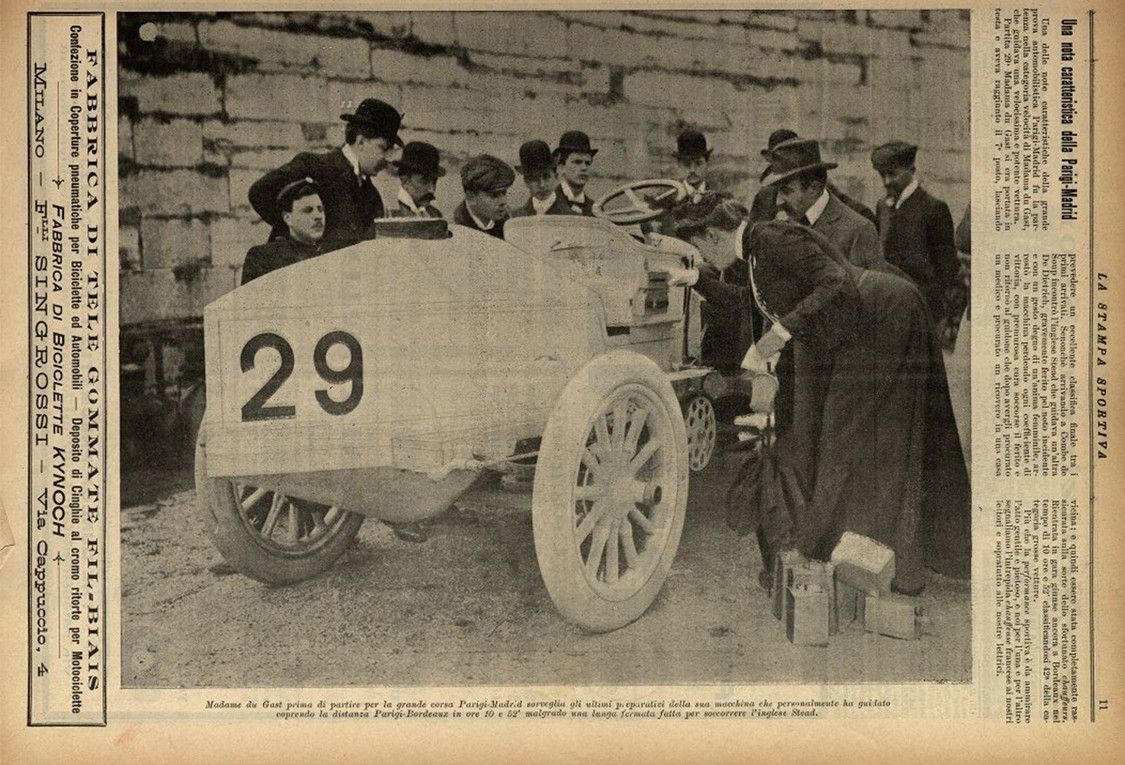
LA STAMPA SPORTIVA – No. 24, Giugno 1903 – Page 11
Una nota caratteristica della Parigi-Madrid
Una delle note caratteristiche della grande prova automobilistica Parigi-Madrid fu la partenza nella categoria velocità di Madama du Gast, che guidava una velocissima e potente vettura.
Partita 29e Madama du Gast si era portata in testa e aveva raggiunto il 7° posto, lasciando prevedere un eccellente classifica finale tra i primi arrivati. Senonché arrivando a Combe do Coup incontrò l’inglese Stead che guidava un’altra De Dietrich, gravemente ferito pel noto incidente e con un gesto degno di un’anima femminile, arrestò la macchina perdendo ogni coefficiente di vittoria, con premurosa cura soccorse il ferito o non ritornò al guidone che dopo avergli procurato un medico e procurato un ricovero in una casa vicina; e quindi essere stata completamente rassicurata sulla sorte dello sfortunato chauffeur. Rientrata in gara giunse ancora a Bordeaux nel tempo di 10 ore e 52′ classificandosi 42a della categoria grosse vetture.
Più che la performance sportiva è da ammirare l’atto gentile e pietoso, e noi per l’ima e per l’altro segnaliamo l’intrepida chauffeuse francese ai nostri lettori e sopra tutto alle nostre lettrici. Madame du Gast prima di partire per la grande corsa Parigi-Madrid sorveglia gli ultimi preparativi della sua macchina che personalmente ha guidato coprendo la distanza Parigi-Bordeaux in ore 10 e 52′ malgrado una lunga fermata fatta per soccorrere l’inglese Stead.
—————-
Translation by Deepl.com.
LA STAMPA SPORTIVA (~Sports Press), Volume II. – Torino – 7 June 1903 – N. 23
Paris-Madrid.
The death of Marcel Renault – Overall standings – Three results for Italian drivers.
The Paris-Madrid race left a trail of blood in its wake, and May 24 will remain written in red letters as a double tragic date in the annals of motor racing.
It marks one of the greatest tragedies in the history of road racing and one of the most serious losses to the automotive industry and sport.
To the list of the humble and unknown victims of this disastrous race, which fortunately remains limited to two cyclists and a soldier, victims of their own recklessness, has been added the glorious name of Marcel Renault, winner of last year’s Paris-Vienna race, one of the leaders of the well-known and respected Bitta Renault Frères of Billancourt, one of the most likeable and daring pioneers of the automotive industry.
Born into a family of wealthy merchants, Marcel Renault founded a car manufacturing company about 15 years ago with his brothers Louis and Fernand, drawn to this industry by his enthusiasm for the new means of transportation, whose promising future he had long foreshadowed. As early as 1899, the type of light car created by the Renaults took a place of honor among the best manufacturers in the automotive industry, winning the first Paris-Ostend and Paris-Toulouse races. And thanks to their long and patient perseverance in their efforts, tirelessly seeking for improvements and refinements, in last year’s great international trial on the Paris-Vienna route, it received the highest reward in a solemn triumph.
In fact, the memory of Marcel Renault’s unexpected victory has not yet faded in the automotive world. By winning the Paris-Vienna race with a 20 HP car, he secured an undisputed primacy as a driver and ensured his brand a well-deserved popularity, marking a clear milestone in the orientation of the automotive industry.
In fact, Marcel Renault’s 20 HP car, beating the 60 and 80 HP giants, proved that even if the ideal to which motor racing aspires is solely that of speed, there is no need to continue the dangerous and crazy race to increase engine power, which now reigns supreme in order to achieve it.
This warning, proclaimed so clearly by the Paris-Vienna race, was to be reaffirmed in the Paris-Madrid race, in which a light Renault car is once again in the lead at the first stage in Bordeaux, beating an army of opponents that has grown in number and, above all, in strength.
But the victory that once again followed the Renault name this year was to be paid for dearly and overshadowed by terrible mourning.
In fact, while Louis Renault, overtaking his competitors who had started before him, arrived first in Bordeaux and placed second in the final standings, his brother Marcel, who had started 63rd, had advanced until he reached Couhé-Vérac (km 331) Théry, who had started 4th, and just as he was about to overtake him, he was the victim of an accident that cost him his life.
It seems that the dust raised by Théry’s car and his position alongside prevented Renault from seeing a sharp bend in the road, so that when he reached it, the car, which was traveling at top speed, skidded with its rear wheels until it hit a curb, spun around, and threw Marcel Renault and his mechanic out. Fortunately, they suffered only minor injuries, while Renault, having hit his head on the ground, suffered a large head wound and was in a critical condition from which he never recovered. He died the following day without regaining consciousness.
The painful news of the accident that had befallen his brother Marcel, robbed Louis Renault of all joy at his victory. As soon as he heard what had happened, he announced that he would abandon the race and ordered all the Renault drivers to stop where they were and rush to the bedside of poor Marcel.
The attempts of medical science were in vain; assisted by all the members of his family, the unfortunate driver died at the age of 33, in the prime of his life, fortune, and glory. The entire sporting and motor racing world in France attended the funeral in Paris last Saturday and, amid great emotion, Rives, on behalf of the Automobile Club de France, and Richard, on behalf of the Chamber of Commerce, paid their last respects to the body of the daring industrialist, who had fallen victim to a tearful and voluntary idea.
On the initiative of Renault mechanics, a subscription has been opened to purchase the plot of land where the accident took place and erect a memorial.
Large cars. — 1 Gabriel (Mors) in 5 hours, 15 minutes and 31 seconds, 2 Salleron (Mors), 3 Jarrott (de Dietrich), 4 Warden (Mercedes), 5 De Crawliez (Panhard), 6 Voigt (C. G. V.), 7 Gasteaux (Mercedes), 8 Ach. Fournier (Mors), 9 Rougier (Turcat-Mery), 10 Monter (de Dietrich), 11 Jenatzy (Mercedes), 12 Max (Mercedes), 13 Le Blon (Serpollet), 14 Berteaux (Panhard), 15 Augières (Mors), 16 Chanliaud (Serpollet), 17 Braun (Mercedes), 18 Teste (Panhard), 19 Lavergne (Mors), 20 Rigolly (Gobron-Bnllié), 21 De Caters (Mercedes), 22 Kohler (Mercedes), 23 Lamberjack (Panhard), 24 Guders (Pipe), 25 De Brou (de Dietrich), 26 Langlois (P. L.), 27 Van de Poêle (Pipe), 28 Barbaroux (Benz), 29 Gavaris (P. L.), 30 Charron (C. G. V.), 31 D’Udekem (Serpollet), 32 Ilieronymus (Mercedes), 33 Duray (Gobron-Brillié), 34 Durand (Mors), 35 Van der Eyden (P. L.), 36 Degrais (Mercedes), 37 Lafont (de Dietrich), 38 Ollivier (Serpollet), 39 Caillels (Serpollet), 40 Holder (Holder), 41 Koeehlin (Go-bron-Brillié), 42 M. me du Gast (de Dietrich), 43 Turr (P. L.), 44 Beutler (de Dietrich), 45 Comlot (C. G. Y.), 46 Stéphen Ribes (P. L.), 47 Gasté (Automotrice), 48 Ambiarli (Mors), 49 Lillie (Serpollet).
Light cars. — 1 L. Renault (Renault) in 5 hours 33 minutes 59 seconds, 2 Baras (Darracq), 3 Page (Décauville), 4 Hemery (Darracq), 5 Peleisson (De Dion Bouton), 6 Tery (Décauville), 7 Edmond (Darracq), 8 Sinc-holle (Darracq), 9 Osmont (Darracq), 10 Bardin (De Dion-Bouton), 11 Giraud (C. G. V.), 12 Rauson (Clément), 13 Simon (Ader), 14 Valentin (Ader), 15 Chenu (Chenu), 16 Loste (C. G. V.), 18 Vessin (Auto-Motobloc), 18 D’Hespel (D‘ Hespe!l, 19 Storero (Fiat), 20 Dombret (Auto-Motobloc), 21 Dernier (Clément), 22 Davaud (P. Lambert), 23 Deniot (Enriot), 24 Pepsan (Corre), 25 Quiuzeaut (A-der), 26 Pagliano (P. Lambert), 27 Dombret (Auto-Motobloc). Small cars. — 1 Masson (Clément) in 7 hours 19 minutes 57 seconds, 2 Barilier (G. Richard), 3 Wagner (Darracq), 4 Combier (Richard), 5 Holley (De Dion-Bouton), 6 Legras (Passy-Thellier), 7 Maurice Fournier (Clement), 8 Birnbaum (Ader), 9 Vilain (Prenel), 10 Villemain (Darracq), 11 Weisser (De Dion-Bouton), 12 Sommier (Adtr), 13 Corre (Corre), 14 D’Houdeauville (Passy-Thellier), 15 Gautier (Ader), 16 Maillard (G. Richard), 17 Aron (Corre), 18 Lebertre (de Dion-Bouton), 19 Flouret (Flou-ret), 20 De Boisse (De Boisse), 21 D’Aubignon (Ader).
Motorcycles. – 1 Bouquet (Werner), 2 Demester (Griffon), 3 Jollivet (Griffon), 4 Cissac (Peugeot), 5 Lanfranchi (Peugeot), 6 Derny (Clément), 7 Griet (Griffon), 8 Momo (Peogeot), 9 Prost (Doué), 10 Arnolt (Werner), il Marïell (Griffon), 12 Baret (Mot. Bruneau), 13 Maillard (Werner).
As can be seen, the Italians participating in the Paris-Madrid race did not have much luck. Lancia withdrew immediately after the start. Storero, who started in 44th place, achieved remarkable speed in the first half of the race, managing to overtake about twenty competitors. However, he then suffered some mechanical problems and arrived in Bordeaux in 79th place, in a time of 10 hours and 45 minutes.
Lanfranchi finished 5th in the motorcycle category in a time of 9 hours and 50 minutes. Momo finished eighth in 11 hours and 3 minutes. Pagliano from Naples was 26th in the light car category, in which Storero took 19th place.
Foto captions.
First page. THE CARS OF THE PARIS-MADRID.
Rigolly Winner of the Arenberg Cup (for alcohol) with the 120 HP. Gobron Brillié.
Page 8. The unfortunate Marcel Renault on his arrival in Vienna in the Paris-Vienna race last year.
Page 11. The 90 HP type prepared by Mercedes for the Paris-Madrid (car of the Baron de Caters).
LA STAMPA SPORTIVA – No. 24, June 1903 – Page 11
A characteristic feature of the Paris-Madrid race
One of the notable features of the great Paris-Madrid motor race was the start in the speed category of Madame du Gast, who was driving a very fast and powerful car.
Starting in 29th place, Madame du Gast took the lead and reached 7th place, promising an excellent final ranking among the first to arrive. However, upon arriving at Combe do Coup, she encountered the Englishman Stead, who was driving another De Dietrich. Seriously injured in the well-known accident, with a gesture worthy of a woman’s soul, she stopped the car, losing any chance of victory, She took care of the injured man with great attention and did not return to the race until she had found him a doctor and arranged for him to be taken to a nearby house. She was then completely reassured about the fate of the unfortunate driver. Returning to the race, she arrived in Bordeaux in a time of 10 hours and 52 minutes, finishing 42nd in the large car category.
More than her sporting performance, it is her kind and compassionate act that is to be admired, and for both reasons we commend the intrepid French driver to our readers, especially our female readers. Before setting off on the great Paris-Madrid race, Madame du Gast supervises the final preparations of her car, which she personally drove from Paris to Bordeaux in 10 hours and 52 minutes, despite a long stop to rescue the Englishman Stead.
